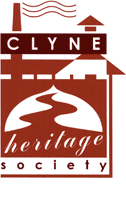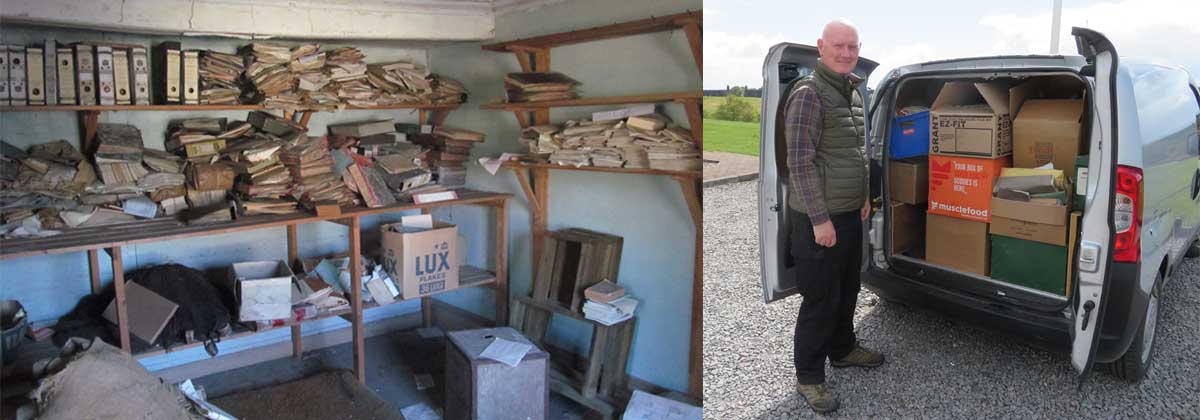
Clyne Heritage Society

The Gordonbush Estate papers - project outline
-
Acquiring the Gordonbush Estate papers collection
In 2015, CHS received, as a legal deposit from Gordonbush Estate in Strath Brora, a huge historic collection of their estate papers, dating from around 1895 up to the early 1960s. The collection was deemed surplus to requirements by the estate and had been earmarked for destruction; however, the Estate Factor, who had been charged with the task of its disposal, was aware that CHS may be interested and he contacted the Society to see if this was the case.
CHS viewed the collection and, at once, realised its significance and agreed to take control of the collection by getting the Estate Factor to sign the CHS Object Entry Form, which legally assigns object donations to the Society. Over a number of weeks, CHS removed the collection from where it had been stored for decades in a cold, damp, dusty, unheated outbuilding, to a more stable environment in a building in Brora, where its archive collection is stored.
Examples of the composition of the collection include all of the estate's incoming and outgoing correspondence (as well as much of the personal correspondence of estate owners), ledger books, game and fish records, estate employment records, cheque stubs, receipts, annual accounts, agricultural and forestry returns, inventories of lodges, legal documents, lease agreements and periodicals, to name but a few.-
How does the Collection fit with the charitable purposes of CHS?
Charitable Purpose 2.5 of the current CHS Articles of Association, Rules and Bye-Laws states that the organisation shall seek ‘To acquire, by means of gift, purchase or loan, historical relics and records for the purpose of exhibition, preservation and safe custody.’
A further two of CHS’s Charitable Purposes (2.9 & 2.10) further enhance the case for taking over the ownership of the collection in that the organisation shall seek: ‘To encourage, support and carry out research into matters of historic and general interest in the area, and to publish the results in suitable form’ and ‘To maintain liaison with educationalists and by means of meetings, lectures, exhibitions, publications and general publicity, to encourage students and others to take an interest in the aims of the Society.-
Consultation with professionals and academics
On receipt of the collection, which had been stored for decades in poor environmental conditions, CHS sought advice from High Life Highland’s Senior Conservator at the Highland Archives in Inverness, and it has since undergone cleaning and stabilisation.
Recognising the importance of the collection, CHS then sought research collaboration with the Centre for History (CfH) at the Dornoch Campus of the University of the Highlands & Islands (UHI), and the Centre for Scotland's Land Futures (CfSLF), an inter-institutional and inter-disciplinary research centre which is led by the UHI, in partnership with University of Stirling and University of Dundee, with a view to its initial cataloguing and interpretation.
The collection represents a unique and fascinating insight into the social history of a highland sporting and agricultural estate in the 20th century, with special reference to three crucial time periods: WWI; the post war depression; and WWII.
Because the collection has particular strengths in the 20th century, it represents an immensely rare and valuable asset. Very few estate papers collections that cover the twentieth century exist in public hands; most being retained by estates, with collections ending around 1900. This collection is of great interest for people living in the parish, or for people whose families once did, as well as a wider scholarly interest among academic historians, geographers, sociologists, folklorists and others.-
Aims for the Gordonbush archive
The vision of CHS for the Gordonbush collection is for it to be catalogued, conserved, interpreted, displayed and safeguarded.
Objectives• to catalogue the collection;
• to encourage volunteer participation in the cataloguing process, under the supervision of the Project Archivist;
• to understand the content of the collection;
• to determine if the collection requires any conservation intervention;
• to record progress and interesting significant discoveries using social media to capture a worldwide audience during the lifetime of the cataloguing project;
• to draw on the collection for articles and/or publications, in order for the social and genealogical histories contained within the collection are made available to a wider general and academic audience;
• to promote the collection to local residents (including school classes) and visitors during the lifetime of the project and beyond;
• to display material from the collection to the public in both a short-term exhibition in Brora and, subsequently, a more permanent exhibition in CHS’s new heritage centre;
• to make the catalogue available to a worldwide audience through the CHS website;
• to store and care for the collection.
-
The way forward
It has been agreed between CHS and the CfH that the best way forward to maximise interest and use of the resource is to appoint a professional Project Archivist to catalogue the entire collection, to train volunteers in archive skills and to recommend a follow-on plan of action for conservation, research, interpretation and display.
It has been agreed by the Board of Clyne Heritage Society to pursue funding options in order to make this project happen.